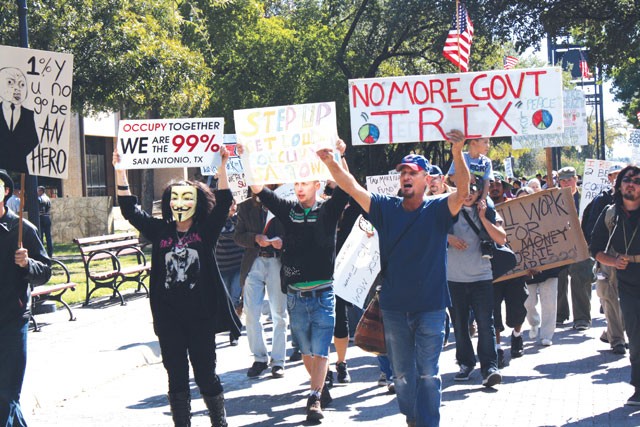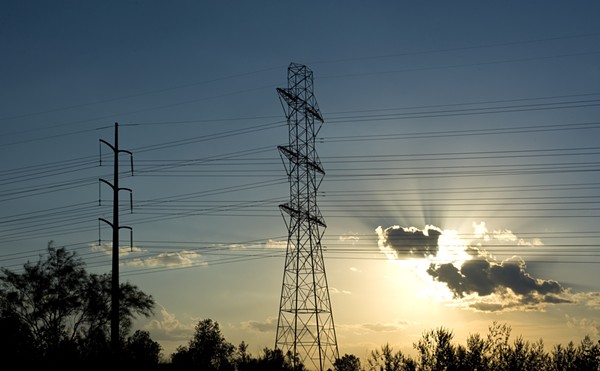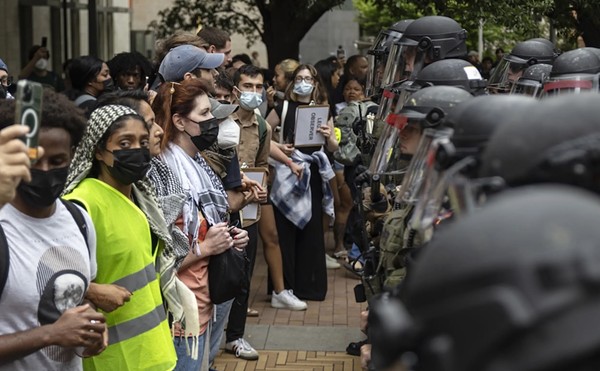
A homeless man crushed inside a city garbage truck Monday on the city’s Southside provided the rallying cry for Occupy San Antonio protestors gathered in HemisFair Park. As drums began to ring through the night air, the group of about 30 took to the streets in yet another show of insult and outrage in this Age of Austerity, as Republicans and Democrats negotiate major cuts in federal assistance programs to rein in a skyrocketing national debt.
“Banks got bailed out! You got sold out!”
By now most everyone has read about or seen news snippets of the reverberations of mid September’s Occupy Wall Street engagement in New York City’s Zuccotti Park and heard the demands for banking reform and a loosening of corporate money control on national politics (or as a sign held aloft at a march in San Antonio this weekend expressed: a “Separation of Corporation and State”). Mass arrests on the Brooklyn Bridge. Non-violently protesting U.S. Marine Scott Olsen brained by police in Oakland. This week, the local Occupy San Antonio — a far less confrontational, but just as committed group making regular rounds about downtown — turns one month old. And for the handful of locals camping in HemisFair, every day is a victory. Not to say there haven’t been skirmishes and headaches. If it’s not a television crew rolling up at 5 a.m. scouting for a potential morning show guest, it’s a misguided group of vandals seeking trouble or a park visitor threatening to bust the handheld videocameras the small band of core protestors use to record much of their interactions with the public and the media.
But Occupy SA protestors are most concerned about how their message is relayed to the world. When a park visitor goes on camera with a team from WOAI, for instance, curious camera-toting protestors come out to film. These small cameras sometimes draw another reaction. In this case, the station’s interview subject threatened to break them, prompting the protestors to call on park police.
It’s standard protocol for those rallying in support of the Occupy Wall Street movement to shadow the media. When an interview is obviously edited in a way that disparages the group, as many here feel the WOAI footage was (there’s no suggestion that the subject of all those lenses was being interviewed by WOAI’s team when he started threatening the group’s handhelds, for instance), the original unedited exchange is quickly hoisted online.
And in that theater, the message, many say, too often gets lost.
“Here it is, in a nutshell,” offers local supporter Bonnie Karl in her distillation of the Occupy meme: “Unfettered capitalism has led to economic apartheid. Is that easy enough?”
While there have been TV pundits and politicians more than willing to lambast the protestors for their methods, it seems increasingly few are willing to take on the movement’s prime tenant of economic injustice. Probably because it’s rooted in hard data and, harder yet, lived experience of the housing market collapse and recession. Last week the U.S. Congressional Budget Office released its findings that since 1979 income disparities have increased dramatically in the United States, with the richest 1 percent of Americans watching their after-tax earnings climb by an average 275 percent, doubling the one-percenters’ share of national wealth. During the same period, the poorest families saw only 18 percent growth. While bank bailouts have sucked up hundreds of billions of dollars, one in five American homeowners suddenly find themselves owing more on their homes than the things are worth. Try finding debt forgiveness there. It’s called foreclosure.
We’re all the 99 percent
Saturday’s familiar refrain marching past the Alamo in support of the Robin Hood tax — a proposal to the G20 leaders assembled in France from global Occupy — was a simple one: “The banks got bailed out! You got sold out!” As we wind along the sidewalks and into Alamo Plaza, the public’s support of the message seems obvious: horns honk, thumbs are raised, waves, smiles. Only a couple of disgruntled Alamo tourists spit epithets like “get a job” — an obvious non-starter given the recessionary reaction at the heart of the occupation. The plight of the “99 percent” is something even the security guard inside the Bank of America building seems to understand today. After pulling a flyer through the tinted door, he flashes the victory sign to the group of 50-some marchers as they pass. Despite what some more seasoned local activists consider an overly deferential attitude toward the police (the campers relocated from first choice Travis Park to HemisFair at the City’s request), it seems the police, too, get it. One Park Police officer riding by on his bike also flashes a peace sign as he peddles past. In the parlance of what has become a global movement: they are a part of the 99 percent, too.
Along the route, we’re joined by a few onlookers. One of these introduces himself as Julio and comments on the absence of the established social-justice organizations. “For me it’s more of a class war: the working class versus the bourgeois,” he says. “Nowadays people that have jobs have to work harder, they work longer, for less benefits or no benefits at all. And they’re not allowed to say anything, because there’s a thousand applicants right there behind them.”
Jobs are down; American productivity is way up. Workers are running scared.
“If the economy is growing but only a few are enjoying the benefits, it goes to our sense of fairness,” economist Emmanuel Saez told The New York Times recently. “It can have important political consequences.”
Why they occupy
Guy Fawkes’ masks aside, the makeup of Occupy San Antonio is not one of familiar faces. That is: these are not habitual protestors. They are our unemployed and homeless. They are local high-tech workers and teachers. Most seem to be getting their first taste of marches and sign-waving. And they are veterans. That last fact shouldn’t come as a surprise. According to a recent study by the U.S. Department of Veterans Affairs and the Department of Housing and Urban Development, a disproportionately large share of young U.S. veterans are homeless — though 18 to 30 year olds make up only 5 percent of the nation’s veteran population, they are 9 percent of the 145,000 veterans that were homeless at some point last year.
As a former business owner and veteran, lifelong San Antonio resident Julio Gonzales resisted the message of Occupy at first. But it began to stew inside him, and he’s since attended march after march weaving through downtown. “It might be a little late for me, but I’m doing this for my grandkids,” he told me. “I mean the banks got bailed out nice and easy. Their CEOs are still making over $300 million a year, and what do you do with the people who lost their homes, their cars, the good jobs they had?”
Sharon Young came searching for Occupy SA on her own. When she found them the conversations inspired her, and she brought the group food the next day. “I just started identifying with different people, and different things, things we hand in common, things we were fed up with, but also sharing different philosophies of life and how we have common ground,” she said.
She was inspired on Saturday’s march to “shower praise” on a couple of uniformed military men on the River Walk. (“We believe in our country. Government may not agree with us, but we would like them to get on board with us eventually.”) And talk with others gathered in the park about President Franklin Delano Roosevelt’s hoped-for “second” bill of rights to include such things as the right to medical care and “decent” homes for every American inspired her enough to stick around. “That’s what I was looking for. We all need a living wage, we’re all in this together.”
Eric Fahrenthold had grown increasingly frustrated trying to ferret out the real news behind the Jasmine Revolution sweeping the Middle East by the time Occupy Wall Street hit. He was so enthralled that he thought about quitting his sales job in town and heading for Manhattan, but when he saw that even usually liberal commentators were deriding the movement he knew it was here to stay for awhile. “I knew that was feeding the fire,” he said over the weekend. “Slowly I realized how long this was going to take and how beautiful of a thing it was.” He hit formative gatherings in Austin before discovering a local movement building here at home, where he has since been investing his energy. “I would like to hope this absolutely blows up, in a peaceful way,” he said.
The conversations ahead
It’s been a slow, and sometimes ugly, birthing process for the core Occupy SA contingent. Just a scan of the group’s Facebook page will reveal a number of people who have experienced disappointment when attempting to raise issues of gender and race into the group conversation. It’s an oversight starting to be addressed in other camps, such as New York and California.
Although the leadership of 23-year-old social-justice organization Southwest Workers Union on East Commerce Street provided office space for one of the formative Occupy organizing meetings, the group has not joined the movement. SWU Director Genardo Rendon said an organizer from SWU spoke at a recent Occupy gathering about gender and race equality to a lukewarm reception. “Our organization has worked around racial justice, equity for low-income people of color, and those race, class, gender talking points here in San Antonio [aren’t happening with Occupy],” he said. That said, there is room for growth and increased awareness. “We have to work and educate people. Even though we’re not at the center of the process here in San Antonio we support people coming out into the street and asking for accountability. That’s what our organization is about.
“The message is one that’s reverberating across many families. People are tired, you know? People have been struggling. The one-percenters are getting away with everything.”
No stranger to protest herself, Graciela Sánchez, director of the Esperanza Peace & Justice Center (“We’ve been out there since Reagan, and we’ve never stopped”), is happy to see the Occupy movement getting national media attention, but is also hoping for a shift in the conversation. Politicians are actively “demonizing the people who have the least: right now it’s immigrants, it’s queer people, it’s dark people. And if Occupy Wall Street, Occupy San Antonio don’t take all those things into consideration then we’re just really shortsighted. There has to be a lot more work about those issues and what they mean in this very local economy.”
Forward
San Antonio Police credit the Occupy members for their cooperation and say there have been only very minor incidents to date. On Monday, the group moved camp from a shady back corner of HemisFair Park for a spot closer to the front gate to make way for park guests who made a reservation for their spot behind the playground. Yet one woman appearing on the scene for the first time questioned the continued low-conflict philosophy here — something its core members are proud of. She suggested the economic Wall Street of San Antonio is the River Walk itself and that the group should be occupying something more central to the city. “I mean, I don’t recall us asking Saddam’s permission to occupy his country, and what we’re doing here is a hell of a lot more legal.”
But one thing all those interviewed camped out seemed to agree with is that the movement is just getting started. Despite criticism that has come from left and right, Occupy San Antonio members have done the hard work of setting up, developing a working community based on group consensus, and organizing the taxing day-to-day business of feeding and sheltering fellow protestors under difficult circumstances. Members are assigned roles such as “peacekeepers,” for instance, and public restrooms are being cleaned at least three times per day. In short, the group is organized for the long haul.
“I think a lot of people are seeing that we’re not going to see these reforms in this election,” Fahrenthold said. “If they’re not heard a year from now, if they’re still being laughed at a year from now...” he pauses already considering the possibility of that frustration. “There has to be some kind of change. I see that being the outcome.”
Gonzales sees something bigger than politics playing out. “My brothers say if I feel right doing it, go for the gusto,” he said. “Like we used to when we were kids: wild and crazy, but we got our way. And we are going to do it. We are going to fight this and we are going to win. It’s not going to be quick. In my heart, it’s going to take some years. But it’s going to get done.”
While Occupy has targeted a couple local landmarks in its many protest marches, how the movement morphs to meet the specific needs of San Antonio as a whole remains to be seen. That conversation appears to be just beginning. •
View a slideshow of Saturday's march
Occupy Credit Unions
Want to stick it to the banksters but don't have the stamina for all that camping and marching? Consider participating in Bank Transfer Day on November 5 (England's Guy Fawkes Day, cutely) and take your money out of the for-profit behemoth that snookered the world economy and join a local not-for-profit credit union. While the majors — Bank of America and Wells Fargo — are now dropping wildly unpopular extra monthly fees announced recently, the number of people pledging online to make the switch continues to rise. Y tu, Bubba? (More at facebook.com/Nov.Fifth)
For more information
Occupy gathers in HemisFair Park most nights at 7pm for General Assembly meetings. Find out more at facebook.com/occupysanantonio.
Click on the different pictures to hear the Voices of the occupation.


















